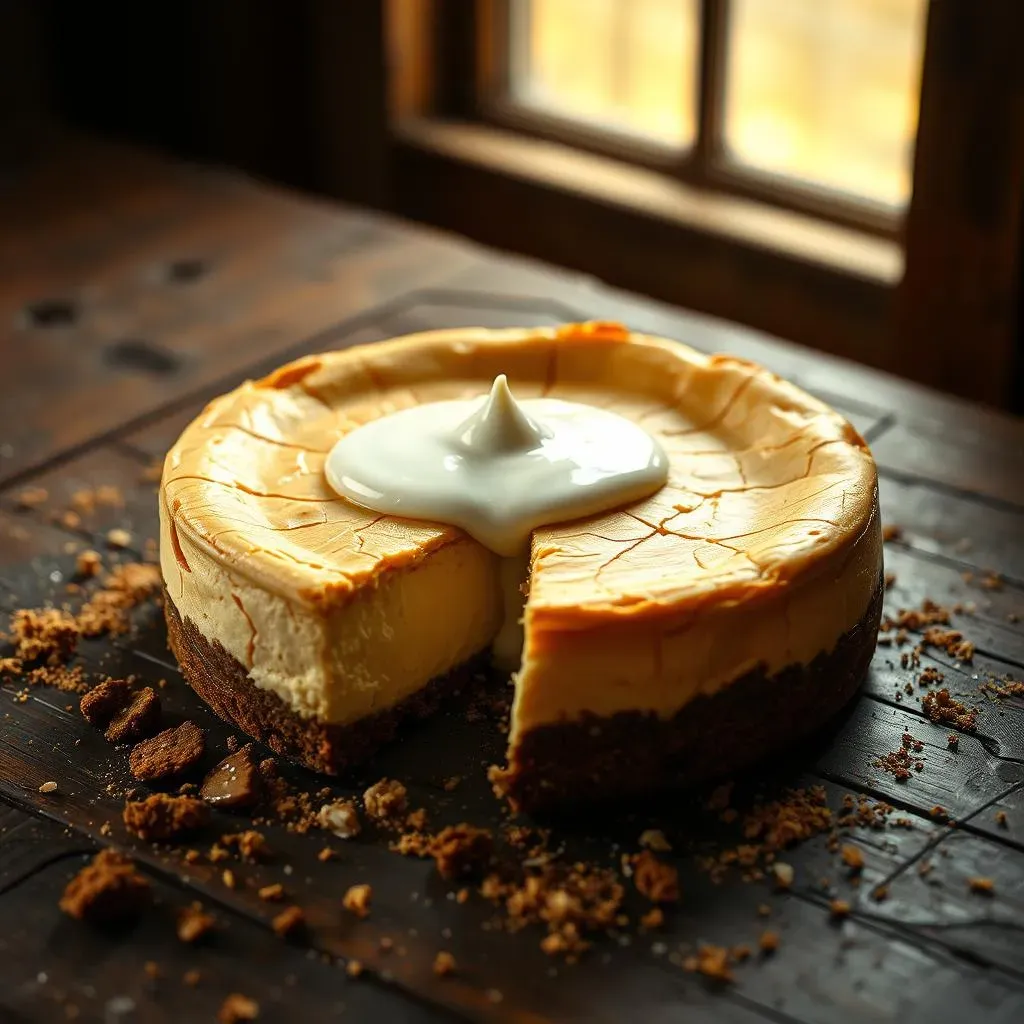Table of Contents
Ever stared blankly at a recipe, realizing you're missing a key ingredient – cream cheese? And all you have is sour cream? The question burning in your mind: "Can you substitute sour cream for cream cheese?" This article dives headfirst into that culinary conundrum, offering a comprehensive guide to help you navigate this common cooking challenge. We'll explore the nuances of substituting sour cream for cream cheese in both sweet and savory dishes, revealing when this swap works wonders and when it might lead to a kitchen catastrophe. We'll examine the textural and flavor differences between these two dairy delights, providing practical tips and advice to ensure your culinary creations are a resounding success. Whether you're baking a decadent cheesecake or whipping up a zesty dip, this guide will equip you with the knowledge to confidently decide if sour cream is the right replacement for cream cheese in *your* recipe. Let's get started and unlock the secrets to successful ingredient substitutions!
Can You Substitute Sour Cream for Cream Cheese in Baking?

Can You Substitute Sour Cream for Cream Cheese in Baking?
Texture Troubles: The Great Density Debate
Let's be honest, cream cheese and sour cream aren't twins. Cream cheese boasts a thick, dense, and almost buttery texture. Sour cream, on the other hand, is tangier and significantly thinner. This difference is crucial in baking. In recipes relying on cream cheese's richness to create structure (like cheesecake!), swapping it for sour cream will result in a much thinner, potentially runny, final product. Your beautiful cheesecake might collapse, your brownies might become soupy, and your cookies might spread like wildfire on the baking sheet. It’s not a pretty picture.
Think of it like building a sandcastle. Cream cheese is the sturdy, packed sand that holds its shape. Sour cream is more like loose, wet sand – it's less stable and prone to crumbling.
Ingredient | Texture | Baking Suitability (as Cream Cheese Substitute) |
|---|---|---|
Cream Cheese | Thick, dense, creamy | Excellent for structure and richness |
Sour Cream | Thin, tangy, less dense | Poor for structure; may lead to overly moist or runny results |
Flavor Fiasco: A Tangy Turn
Beyond texture, flavor plays a significant role. Cream cheese offers a mild, almost sweet creaminess that complements many baked goods beautifully. Sour cream, however, introduces a distinct tang. This tanginess can clash with the delicate flavors of some desserts. Imagine adding sour cream to a delicate vanilla cake – the sharp tang might overwhelm the subtle sweetness, creating an unexpected and potentially unpleasant taste. While some recipes might tolerate a touch of tang, it's not a universal baking friend.
Consider the overall flavor profile of your recipe. If you're aiming for a subtle sweetness, sour cream's tartness might be a deal breaker. If you're baking something with a more robust flavor profile (like a spice cake), the tang might be more acceptable, but proceed with caution!
- Cakes: Sour cream often clashes with delicate flavors.
- Cheesecakes: A complete disaster. Avoid at all costs.
- Cookies: May result in overly spread-out, flat cookies.
When Sour Cream *Might* Work (with caveats!):
Now, before you completely banish sour cream from your baking repertoire, there are a few exceptions. In some recipes, a small amount of sour cream can add moisture and a slight tang without significantly altering the texture. Recipes where a slightly thinner, tangier consistency is acceptable might benefit from a small substitution. However, remember that you're venturing into experimental territory. Start with a small substitution (maybe a quarter of the cream cheese amount), and carefully monitor the results. Baking is a science, not just an art, and this substitution is closer to a controlled experiment.
Always test a small batch first! If you're unsure, it's best to stick to a proper cream cheese substitute or simply adjust the recipe to omit the cream cheese entirely. Many recipes can be adapted, and it's always better to make a conscious recipe change than to risk a baking disaster.
Using Sour Cream as a Cream Cheese Substitute in Savory Dishes

Using Sour Cream as a Cream Cheese Substitute in Savory Dishes
A Smoother Swap: Soups, Sauces, and Dips
Unlike baking, where cream cheese's structure is key, savory dishes often tolerate a bit more flexibility. Sour cream's thinner consistency can actually work to your advantage in soups, sauces, and dips. It blends seamlessly, adding a creamy richness and a pleasant tang. Think creamy tomato soup, a luscious pasta sauce, or a zesty spinach and artichoke dip. The tang of the sour cream can even enhance the overall flavor profile, adding a bright counterpoint to richer ingredients.
However, remember that sour cream's tang is more pronounced than cream cheese's mildness. If you're aiming for a neutral base, you might want to temper the sour cream with a touch of milk or cream to mellow out the flavor. Also, consider the recipe's other ingredients – will the tang complement them, or clash? A taste test is always your best friend.
Dish | Sour Cream Works Well? | Considerations |
|---|---|---|
Creamy Tomato Soup | Yes | May enhance the overall flavor |
Pasta Sauce | Yes | Adds creaminess and a touch of tang |
Chili | Potentially | Adds creaminess but might clash with spice levels |
Texture Tweaks: Achieving the Right Consistency
While sour cream's thinner consistency works well in many savory dishes, it's not a one-size-fits-all solution. Some recipes might require a thicker texture. If the recipe calls for cream cheese as a thickener, you might need to adjust the sour cream's consistency. You can thicken sour cream by using a simple trick: gently heating it and allowing it to simmer for a short time on low heat. This will reduce the water content, leaving a slightly thicker, more concentrated creaminess. Alternatively, you can mix in a small amount of cornstarch or flour to achieve the desired thickness. Always whisk in the thickening agent gradually to prevent lumps.
Remember, the goal is to mimic the cream cheese's role in the dish. If it's acting primarily as a thickener, you need to ensure the sour cream replacement provides the same function. If it's adding flavor and richness, focus on balancing the tang.
- Heat sour cream gently to thicken it.
- Add cornstarch or flour for extra thickness (whisk well!).
- Adjust the amount of sour cream based on the desired consistency.
Beyond the Basics: Creative Applications
Don't limit yourself to just replicating cream cheese's function. Sour cream can bring its own unique qualities to the table. Its tangy flavor can add a delightful dimension to certain savory dishes. For instance, in Mexican cuisine, sour cream is often used as a topping, adding a contrasting coolness to spicy dishes. Its slightly acidic nature can also help to balance out richer, heavier flavors. Consider how the sour cream's tang might enhance the overall taste of the dish. It might be the unexpected twist your recipe needs!
Experiment! Don't be afraid to try substituting sour cream in unexpected ways. You might discover a new favorite flavor combination. Remember, cooking is all about creativity and exploration. Embrace the unexpected!
Understanding the Differences: Sour Cream vs. Cream Cheese for Optimal Results

Understanding the Differences: Sour Cream vs. Cream Cheese for Optimal Results
Fat Content and Consistency: A Tale of Two Textures
Let's get down to the nitty-gritty: fat content. Cream cheese is a heavyweight champion, boasting a much higher fat percentage than sour cream. This high fat content is what gives cream cheese its thick, dense, and spreadable texture. It's the reason it holds its shape so well in baking and provides that luscious, creamy mouthfeel. Sour cream, while creamy, has a significantly lower fat content, resulting in a thinner, more pourable consistency. This difference in fat impacts not only the texture but also how the ingredients behave in a recipe.
Think of it this way: cream cheese is like a well-oiled machine, smooth and powerful. Sour cream is more like a nimble dancer, light and fluid. Understanding this fundamental difference in fat content and resulting texture is crucial for making informed substitution decisions.
Characteristic | Cream Cheese | Sour Cream |
|---|---|---|
Fat Content | High | Lower |
Texture | Thick, dense, spreadable | Thin, pourable, less dense |
Flavor Profile | Mild, slightly sweet | Tangy, acidic |
Flavor Profiles: Sweet Creaminess vs. Tangy Tartness
Beyond the textural differences, the flavor profiles of cream cheese and sour cream are distinctly different. Cream cheese offers a mild, almost subtly sweet creaminess, making it a perfect complement to sweet and savory dishes alike. Its mildness allows other flavors to shine through without being overpowered. Sour cream, on the other hand, boasts a much more pronounced tangy and acidic flavor. This tartness can be delightful in certain applications, adding a bright, refreshing counterpoint to richer or spicier dishes. However, this tanginess can be overwhelming or clash with delicate flavors in other contexts.
Consider the recipe's overall flavor profile. If you're working with delicate flavors, sour cream's pronounced tang might be too much. If you're aiming for a bolder flavor, its tartness could be a welcome addition. Remember, a successful substitution requires considering not just the texture but also the interplay of flavors in your recipe.
- Cream Cheese: Mild, creamy, slightly sweet
- Sour Cream: Tangy, acidic, refreshing
- Consider the recipe's flavor profile before substituting.